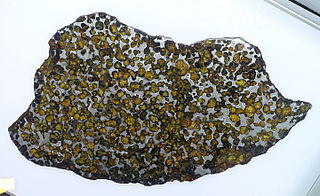This page is based on this
Wikipedia article Text is available under the
CC BY-SA 4.0 license; additional terms may apply.
Images, videos and audio are available under their respective licenses.

Peridot ( or ) (sometimes called chrysolite) is gem-quality olivine and a silicate mineral with the formula of (Mg, Fe)2SiO4. As peridot is a magnesium-rich variety of olivine (forsterite), the formula approaches Mg2SiO4.

The Fukang meteorite is a meteorite that was found in the mountains near Fukang, China in 2000. It is a pallasite—a type of stony–iron meteorite with olivine crystals. It is estimated to be 4.5 billion years old.

Mesosiderites are a class of stony–iron meteorites consisting of about equal parts of metallic nickel-iron and silicate. They are breccias with an irregular texture; silicates and metal occur often in lumps or pebbles as well as in fine-grained intergrowths. The silicate part contains olivine, pyroxenes, and Ca-rich feldspar and is similar in composition to eucrites and diogenites.

Brahin is a meteorite pallasite found in 1807.
This is the second meteorite ever found in Russia.
Sometimes it is also called Bragin or Bragim.
It is quite common among collectors due the affordable price of small partial slices.

Esquel is a meteorite found near Esquel, a patagonian town in the northwest part of the province of Chubut in Argentina. It is a pallasite, a type of stony–iron meteorite that when cut and polished shows yellowish olivine (peridot) crystals.

Brenham is a pallasite meteorite found near Haviland, a small town in Kiowa County, Kansas, United States. Pallasites are a type of stony–iron meteorite that when cut and polished show yellowish olivine (peridot) crystals.

Krasnojarsk was the first pallasite meteorite ever found.

Huckitta is a pallasite meteorite recovered in 1937 from Huckitta Cattle Station, Northern Territory, Australia.

Pultusk is an H5 ordinary chondrite meteorite which fell on 30 January 1868 in Poland. The event has been known as the stony meteorite shower with the largest number of pieces yet recorded in history. Made up of rocky debris, it consists of pyroxene or olivine chondrules deployed in mass plagioclase, there being also kamacite.

Pallasovka is a pallasite meteorite found in 1990 near the town of Pallasovka, Russia.

Seymchan is a pallasite meteorite found in the dry bed of the river Hekandue, a left tributary of river Jasačnaja in the Magadan district, Russia, near the settlement of Seymchan, in June 1967.

Angrites are a rare group of achondrites consisting mostly of the mineral augite with some olivine, anorthite and troilite. The group is named for the Angra dos Reis meteorite.

Moss is a carbonaceous chondrite meteorite that fell over the communities of Rygge and Moss in Østfold county, southeast southern Norway in the morning of midsummer day, July 14, 2006.

The Springwater meteorite is a stony-iron pallasite, found near Springwater, Saskatchewan in 1931.
At that time the find consisted of three large masses (38.6 kilograms, 18.6 kilograms and 10.6 kilograms. Other fragments have been found recently, including a 53 kilograms individual in 2009 that is now in the Royal Ontario Museum.

The Nantan meteorite is an iron meteorite that belongs to the IAB group and the MG subgroup.

The Eagle Station grouplet is a set of pallasite meteorite specimen that don't fit into any of the defined pallasite groups. In meteorite classification five meteorites have to be found, so they can be defined as their own group. Currently only five Eagle Station type meteorites have been found.
The Vermillion meteorite is a pallasite (stony-iron) meteorite and one of two members of the pyroxene pallasite grouplet.

Fifteen pieces of the Kainsaz meteorite were seen to fall near Kainsaz, Muslyumovo, Tatarstan in 1937-09-13. The largest weighed 102.5 kilograms (226 lb), the total weight was ~200 kilograms (440 lb). As of January 2013 pieces were on sale for ~US$100/g. Kainsaz is the only observed fall in Tatarstan.


















